The first and only FDA-approved treatment for adults with NF1-PN*
*Adults with symptomatic PN not amenable to complete resection.
Actor portrayal.

GOMEKLI is proven to shrink plexiform neurofibromas (PNs) in adults with neurofibromatosis type 1 (NF1)1
Primary endpoint: confirmed overall response rate (ORR)1,†
achieved a confirmed response‡
had a deep response
(>50% reduction in PN volume)2
(This analysis was post hoc and exploratory)
In a post hoc subgroup analysis:
Patients who achieved a deep response had a longer duration of treatment than those who did not3
The median duration of treatment for patients with a deep response was 37 months (range: 20 to 46 months) vs 26 months (range: 7 to 33 months) for those with a 20% to 50% reduction in PN volume.
†Confirmed ORR defined as the proportion of patients with complete response (disappearance of the target PN) or partial response (≥20% reduction) on magnetic resonance imaging (MRI) of the target PN volume from baseline to Cycle 24 (treatment phase) as assessed by blinded independent central review (BICR) on ≥2 consecutive scans within 2 to 6 months.1
‡All partial responses.1
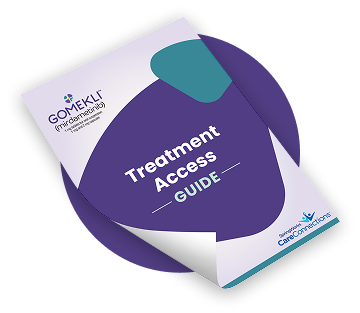
Do you have patients who are starting GOMEKLI?
Download the GOMEKLI Treatment Access Guide for information on how to order GOMEKLI, enroll patients in the CareConnections support program, and more.
Watch this video of Drs. Nghiemphu and Weintraub as they discuss how to help set patients up for a positive GOMEKLI treatment experience.
Clinical overview in adults and case-based insights
Clinical overview in adults and case-based insights
Drs. Nghiemphu and Moertel review the ReNeu efficacy and safety results and present 2 case studies of adult patients who were treated with GOMEKLI.
GOMEKLI logo.
Episode #2: Clinical Overview in Adults and Case-Based Insights
[Dr Nghiemphu]
My name is Dr Phioanh Leia Nghiemphu, and I'm a neuro-oncologist and the director of the UCLA Neurofibromatosis and Schwannomatosis Clinic.
I'm happy to share today that I also have Dr Moertel, one of the lead investigators of the ReNeu study.
[Dr Moertel]
My name is Dr Christopher Moertel.
I'm a neuro-oncologist and I serve as professor of pediatrics at the University of Minnesota School of Medicine, and I'm the medical director of the Comprehensive Neurofibromatosis Clinic at the University of Minnesota Masonic Children's Hospital.
[Dr Nghiemphu]
GOMEKLI is the first FDA-approved treatment for both adult and pediatric patients 2 years of age and older with NF1 who have symptomatic PNs not amenable to complete resection.
At this time, I'd like to pass things over to Dr Moertel, who will give an overview of the ReNeu study for GOMEKLI.
[Dr Moertel]
Thank you!
I'm thrilled to be sharing an overview of the pivotal trial that led to the approval of GOMEKLI.
ReNeu is one of the largest multicenter studies to date of patients with NF1 plexiform neurofibromas.
The efficacy and safety of GOMEKLI were assessed in 114 adult and pediatric patients aged 2 years and older with plexiform neurofibromas causing significant morbidity.
ReNeu was a multicenter, single-arm, phase 2b study with a treatment phase of approximately 22 months, and an optional long-term follow-up treatment phase for those patients who chose to continue treatment with GOMEKLI and a 30-day safety follow-up after treatment discontinuation.
Patients received GOMEKLI based on body surface area at a dosage of 2 mg/m2 orally twice daily on a 3-weeks-on and 1-week-off schedule.
The maximum daily dose of GOMEKLI was 4 mg twice daily.
In both cohorts, the majority of the adult and pediatric patients who completed the treatment phase, with or without a confirmed overall response, chose to remain on GOMEKLI during the long-term follow-up. 84% of adult patients and 85% of pediatric patients made this choice.
The primary endpoint was confirmed overall response rate, which was defined as the proportion of patients with complete response, that is disappearance of the target plexiform neurofibroma, or partial response, a 20% or greater reduction on magnetic resonance imaging of the target PN volume, from baseline to Cycle 24.
That's the treatment phase, and this was assessed by blinded independent central review on 2 or more consecutive scans within 2 to 6 months.
One of the key features of the ReNeu study was that all responses were assessed by blinded independent central review, and MRIs were reviewed by 2 independent radiologists—concordance in response categorization between reviewers was actually very high.
In this study, the secondary endpoints consisted of safety, tolerability, duration of response, and the change from baseline at prespecified Cycle 13 in patient-reported outcomes, or PROs, of worst tumor pain severity, pain interference, and health-related quality of life.
Dr Nghiemphu, I'll turn it over to you to present the efficacy data for the adults in the ReNeu study.
[Dr Nghiemphu]
During the treatment phase, 41% of adult patients who were treated with GOMEKLI achieved a confirmed overall response by REiNS criteria.
Based on a post hoc exploratory analysis, among those patients who achieved a confirmed overall response, 62% achieved a deep response, so that's defined as greater than 50% reduction in the target PN volume from baseline.
This waterfall plot depicts the best percentage change from baseline in tumor volume in adult patients who were treated with GOMEKLI. This was a prespecified exploratory endpoint in the trial.
The teal bars represent adult patients who had a confirmed overall response. The white bars represented nonresponders who had a best overall response of stable disease or progressive disease.
Adults treated with GOMEKLI saw a 41% median reduction in volume of target PNs, and many achieved notable depths of response, with maximum best change being to 90%.
Furthermore, based on a post hoc subgroup analysis, patients who achieved a deep response had a longer median duration of treatment than those who did not achieve a deep response. The median duration of treatment for patients with a deep response was 37 months compared to 26 months for those with just a 20% to 50% reduction in PN volume.
This swimmer plot shows the treatment duration for each patient. Of the 50 evaluable adult patients, 24 had a partial response and 26 had a best response of stable disease.
Note that stable disease and progressive disease were exploratory endpoints, and data should be interpreted with caution, as ReNeu is a single-arm trial.
88% of confirmed overall responders maintained a response for 12 months or more. The median duration of response has not been reached, as the majority of responders are still experiencing a response.
Almost half of the patients, 46%, had an onset of response at the first assessment around Cycle 5, which was approximately 4 months, and the median time to the first response was 7.8 months.
This safety table represents adverse reactions seen in 20% or more of patients.
The most common adverse reactions occurring in greater than 25% of adult patients were rash, diarrhea, nausea, musculoskeletal pain, vomiting, and fatigue.
The majority of adverse reactions were mild to moderate, and there were low rates of severe, Grade 3 or 4, adverse reactions.
For your reference, and to ensure that you and your patients are provided with the support needed, SpringWorks will have a Dosing and Adverse Reaction Management Guide available. This resource includes information on how to manage some of the most common dermatologic and GI side effects, as well as additional information on other adverse reactions.
In the adult cohort, 31% of patients had a dose interruption, and 17% had a dose reduction due to an adverse reaction.
The most common adverse reactions that required dose interruptions were left ventricular dysfunction and COVID-19. Adverse reactions that required dose reductions included rash.
Additionally, 22% of adult patients permanently discontinued GOMEKLI due to rash, diarrhea, nausea, abdominal pain, alopecia, dry skin, left ventricular dysfunction, cough, wheezing, COVID-19, peripheral swelling, retinal vein occlusion, dizziness, and vomiting.
Prior to initiating GOMEKLI, conduct a comprehensive ophthalmic assessment, assess ejection fraction by echocardiogram, and verify the pregnancy status of females of reproductive potential.
During treatment, monitor ejection fraction every 3 months during the first year, and then as clinically indicated. Conduct comprehensive ophthalmic assessment at regular intervals.
Laboratory abnormalities that worsen from baseline and occurred in 15% or more of patients are shown on this slide.
The most common laboratory abnormality was increased CPK.
It is recommended to conduct lab tests prior to initiating treatment and at regular intervals during treatment.
So, now we would like to share case studies of patients who were treated with GOMEKLI in the ReNeu clinical trial.
Before we begin, I would like to note that the profile presented is based on an actual patient who was treated with GOMEKLI. Identifiers have been changed. Every patient's experience is unique and individual results may vary.
The case I will be sharing with you is an 18-year-old female with a painful plexiform neurofibroma in the right breast.
The patient has skin changes and symptoms since birth, but imaging at the age of 12 ultimately led to the diagnosis of NF1.
She is a college student and is active in the NF community.
She presented with multiple PNs, one of which was growing and also was painful.
The tumor first presented when she was around 16 or 17 as a small nodule that grew over the course of a year.
The tumor was not amenable to resection really, because a mastectomy would have been required. The PN diffused through the right breast and involved much of the skin surface.
As you can see from the image here, the PN is evident by the hyperintense white areas on MRI, and there's a nodule on the inside and thickened white areas over the skin.
Her primary symptoms were hyperesthesia, or extreme sensitivity due to the diffuse PN all over her breast; pain; skin discoloration; and misshapen breasts.
For this patient, daily living was quite a challenge, and different-sized breasts made getting dressed and bra sizing very difficult for her.
Wearing clothing was painful due to skin irritation from fabric contact, and she was concerned about just living with misshapen breasts.
Her parents were very involved with her care and came to appointments with her.
She has been taking over-the-counter pain medications and, because of her age, her care team consisted of a pediatric oncologist who helped her in the transition to adult care.
She was enrolled in the ReNeu clinical trial at 18, as she had a painful PN that was not able to be resected.
As I mentioned before, this would have required mastectomy.
She received the capsule at 4 mg twice a day.
The results from the trial for this patient are shown here. These are MRI images shown on the slides are 2D visuals and do not capture the total volumetric changes observed.
These were images I provided, but additional images may have been utilized during the trial to assess full volumetrics.
The patient achieved a confirmed overall response with a best target volume reduction from baseline of 84%.
Her adverse reactions included mild nausea and vomiting; mild rash, which was managed with doxycycline and clindamycin ointment on the face; and intermittent erythematous rash and itchiness, which were managed with clobetasol lotion.
During Cycle 4, she did have some mild alopecia that emerged. It was treated but did not resolve.
The patient now feels her appearance has improved and is managing her medication and medical diary.
As a result of the tumor volume reduction, wearing a bra and clothing is more comfortable, as irritation from fabric touching her skin has decreased.
The tumor volume reduction has remained durable, and her PN remains stable.
She also reconsented and is now participating in the long-term follow-up of ReNeu.
[Dr Moertel]
This case I'm about to show you is regarding a 69-year-old male with a large plexiform neurofibroma in the head and neck region.
The patient has been a social drinker and smoker since his teenage years, and he, his mother, and his sister have a history of stroke.
He has no family history of NF1.
He was referred by his primary care physician for stabbing pain in the right side of his jaw and hearing loss, or muffled hearing.
Magnetic resonance imaging (MRI) scans confirmed a large walnut-sized plexiform neurofibroma.
The progressing PN was diffused around his neck and penetrated into the neck muscles, so it was not amenable to resection.
It also extended into the muscles of his jaw and occluded his ear canal.
His pain was waking him up and he was unable to function with what he referred to as his stabbing pain.
The patient was taking over-the-counter medications for pain and his care team consisted of a primary care physician, a dermatologist, an ophthalmologist, and myself.
He enrolled in the ReNeu clinical trial and received the capsule formulation of GOMEKLI dosed at 4 mg twice daily.
Results from the trial are shown here.
MRI images shown on the slide, again, are 2D visuals and do not capture the total volumetric changes observed.
These were the images I provided, but additional images may have been utilized during the trial to assess full volumetrics.
The patient achieved a confirmed overall response with a best target tumor volume reduction from baseline of approximately 73%. As a result of this tumor reduction, hearing and symptoms improved.
Adverse reactions included a rash on the scalp, for which he was referred to a dermatologist for oral and topical treatment, and at a follow-up visit, his skin was clearer.
He also had mild asymptomatic CPK increase.
The patient opted to reconsent and participated in the long-term follow-up phase of the ReNeu clinical trial, but he discontinued at Cycle 44 after a recurrent stroke unrelated to his treatment.
The patient resumed his art, published a book that he wrote and illustrated, 14 months though, after discontinuing treatment, his symptoms have started to come back.
[Dr Moertel, voiceover only]
I would like to review the highlights of the Important Safety Information.
GOMEKLI can cause ocular toxicity, including retinal vein occlusion, retinal pigment epithelium detachment, and blurred vision.
Conduct comprehensive ophthalmic assessments prior to initiating GOMEKLI, at regular intervals during treatment, and to evaluate any new or worsening visual changes. Follow the dose modification or discontinuation guidance from the Prescribing Information as needed.
GOMEKLI can cause left ventricular dysfunction. It can occur in patients who are treated with GOMEKLI. Before initiating GOMEKLI, assess ejection fraction by echocardiogram and monitor ejection fraction every 3 months during the first year and then as clinically indicated. Withhold, reduce the dose of, or discontinue GOMEKLI, depending on the severity of the adverse reaction.
GOMEKLI can cause dermatologic adverse reactions, including rash.
The most frequent rashes include dermatitis acneiform, rash, eczema, maculo-papular rash, and pustular rash.
Initiate supportive care at first signs of dermatologic adverse reactions and follow the dose modification or discontinuation guidance from the Prescribing Information as needed.
GOMEKLI can cause fetal harm when administered to a pregnant woman.
Verify the pregnancy status of females of reproductive potential prior to the initiation of GOMEKLI.
Because of the potential for adverse reactions in breastfed children, women should be advised not to breastfeed during treatment with GOMEKLI and for 1 week after the last dose.
Advise females of reproductive potential to use effective contraception during treatment with GOMEKLI and for 6 weeks after the last dose.
Advise male patients with female partners of reproductive potential to use effective contraception during treatment and for 3 months after the last dose of GOMEKLI.
Drs. Nghiemphu and Moertel review the ReNeu efficacy and safety results and present 2 case studies of adult patients who were treated with GOMEKLI.
Depth of response achieved by adults2,4
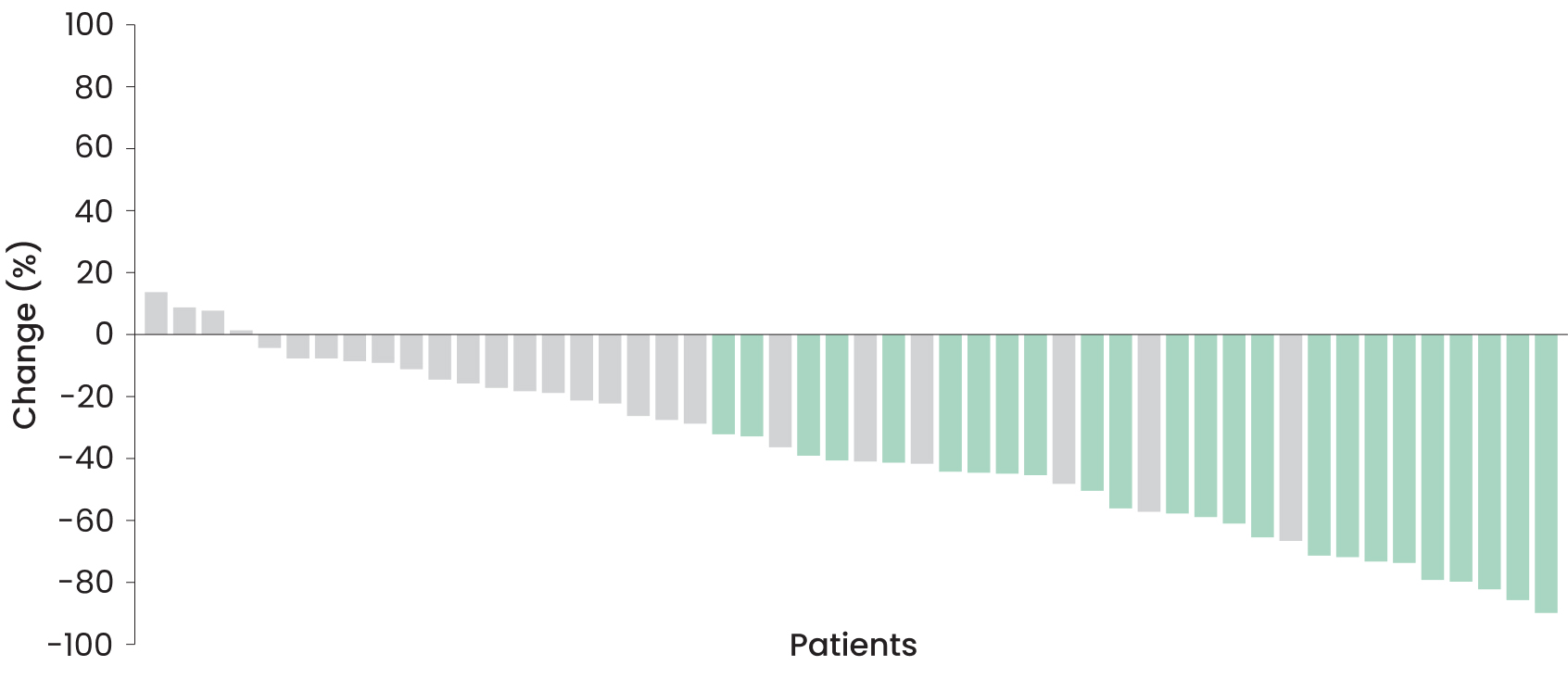
PN volume from baseline2:
-41%
(range: −90% to 13%)
PN volume from baseline2:
-90%
View a deep response case study from ReNeu
40-year-old male with a head/neck PN2
Baseline
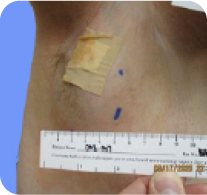
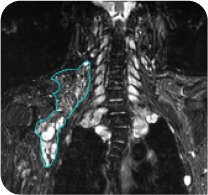
Cycle 36
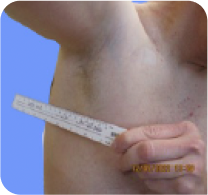
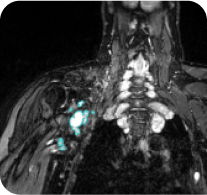
PN with a volume of 281 mL at baseline was reduced to 69 mL (-79%) at Cycle 36.§
Tumor edges are indicated in cyan. Individual results may vary.
§Long-term follow-up phase of the GOMEKLI ReNeu study.

Do you have patients who are starting GOMEKLI?
Download the GOMEKLI Treatment Access Guide for information on how to order GOMEKLI, enroll patients in the CareConnections® support program, and more.
Additional responses in adults seen over time5
-
47% (27/58) of patients achieved a confirmed overall response (all partial responses)
-
67% (18/27) of those with a confirmed response achieved a deep response
-
No new safety signals emerged
Durable response in adult patients1,2
88% (21/24) of the confirmed overall responses remained durable for ≥12 months1,ǁ
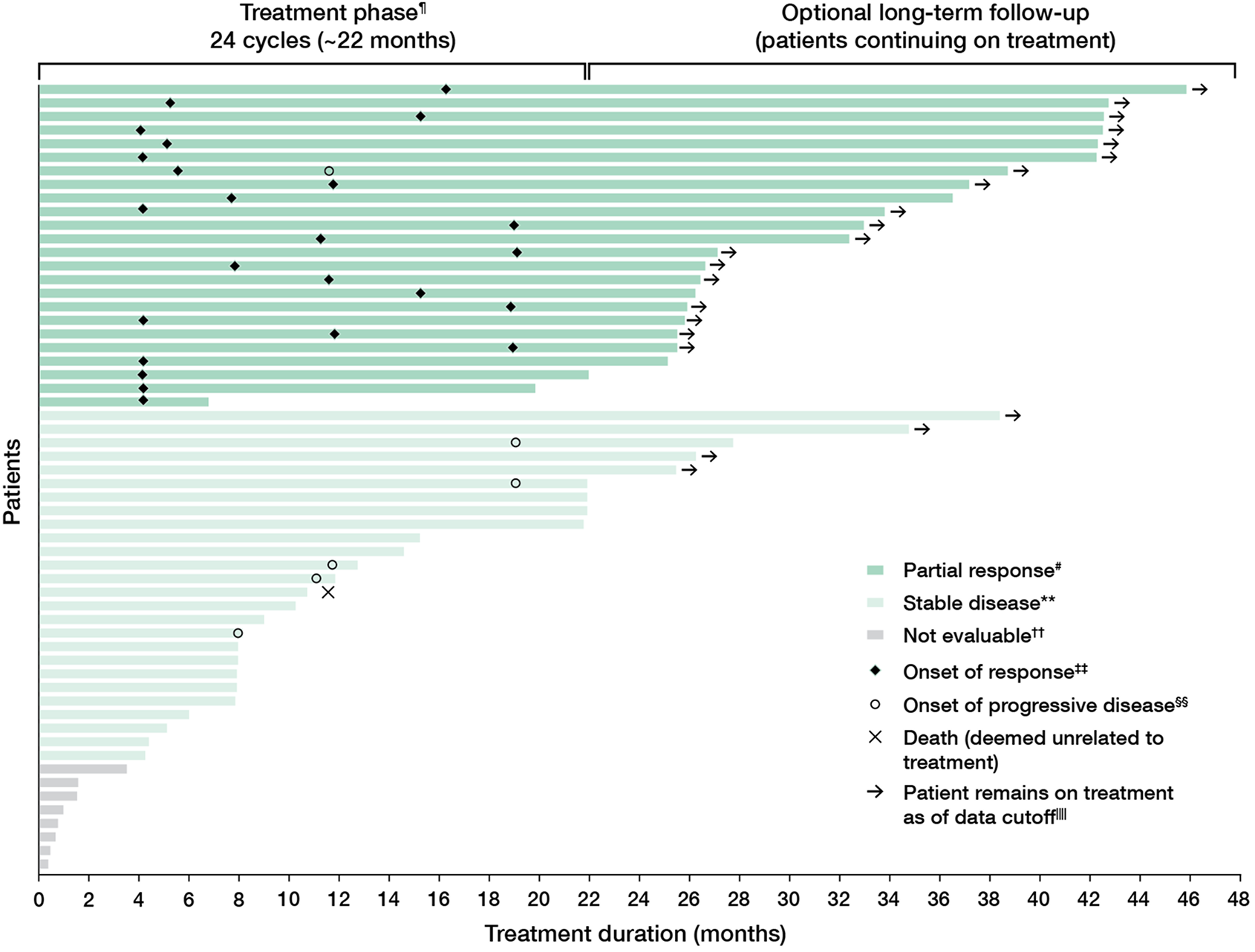
View additional response data
Best overall response status among the 58 adult patients taking GOMEKLI2,4
Complete response
0 patients
Partial response#
24 patients
Stable disease**
26 patients
Progressive disease§§
0 patients
Not evaluable††
8 patients
- All evaluable patients had either an objective response or stable disease based on best overall confirmed response
- 6 patients had disease progression during the treatment phase
- 50% (12/24) of the confirmed overall responses remained durable for ≥24 months1,ǁ
- 46% of responders (11/24) had onset of response at Cycle 5, the first on-treatment assessment (based on a post hoc analysis)4
- Median time to first confirmed response was 7.8 months (range: 4 to 19 months)1
84% of patients
ǁDuration of response was assessed based on observed time.1
¶Four-week cycles of 3 weeks on/1 week off. Treatment phase ends 3 weeks into final cycle.2
#Partial response corresponds with confirmed overall response of ≥20% reduction in target PN volume from baseline.1
††Patients who were not evaluable were those for whom no postbaseline volumetric data were collected.4
‡‡Responses were confirmed on a subsequent scan within 2 to 6 months.2
§§Progressive disease is defined as a ≥20% increase in target PN volume from baseline.2
ǁǁData cutoff was September 20, 2023.2
Discussing GOMEKLI with your patients
The GOMEKLI Patient Brochure can make the ReNeu study data more approachable and easier for you to explain to patients.
Want to learn more about GOMEKLI treatment?
The GOMEKLI Overview Brochure provides an overview of GOMEKLI clinical data for both adult and pediatric patients with NF1-PN.
GOMEKLI safety profile in adults
The majority of adverse reactions were mild to moderate and manageable.1
Indication
GOMEKLI (mirdametinib) is indicated for the treatment of adult and pediatric patients 2 years of age and older with neurofibromatosis type 1 (NF1) who have symptomatic plexiform neurofibromas (PN) not amenable to complete resection.
Important Safety Information
Warnings and Precautions
Ocular Toxicity: GOMEKLI can cause ocular toxicity including retinal vein occlusion (RVO), retinal pigment epithelium detachment (RPED), and blurred vision. In the adult pooled safety population, ocular toxicity occurred in 28% of patients treated with GOMEKLI: 21% were Grade 1, 5% were Grade 2 and 1.3% were Grade 3. RVO occurred in 2.7%, RPED occurred in 1.3%, and blurred vision occurred in 9% of adult patients. In the pediatric pooled safety population, ocular toxicity occurred in 19% of patients: 17% were Grade 1 and 1.7% were Grade 2. Conduct comprehensive ophthalmic assessments prior to initiating GOMEKLI, at regular intervals during treatment, and to evaluate any new or worsening visual changes such as blurred vision. Continue, withhold, reduce the dose, or permanently discontinue GOMEKLI as clinically indicated.
Left Ventricular Dysfunction: GOMEKLI can cause left ventricular dysfunction. GOMEKLI has not been studied in patients with a history of clinically significant cardiac disease or LVEF <55% prior to initiation of treatment. In the ReNeu study, decreased LVEF of 10 to <20% occurred in 16% of adult patients treated with GOMEKLI. Five patients (9%) required dose interruption, one patient (1.7%) required a dose reduction, and one patient required permanent discontinuation of GOMEKLI. The median time to first onset of decreased LVEF in adult patients was 70 days. Decreased LVEF of 10 to <20% occurred in 25%, and decreased LVEF of ≥20% occurred in 1.8% of pediatric patients treated with GOMEKLI. One patient (1.8%) required dose interruption of GOMEKLI. The median time to first onset of decreased LVEF in pediatric patients was 132 days. All patients with decreased LVEF were identified during routine echocardiography, and decreased LVEF resolved in 75% of patients. Before initiating GOMEKLI, assess ejection fraction (EF) by echocardiogram. Monitor EF every 3 months during the first year and then as clinically indicated. Withhold, reduce the dose, or permanently discontinue GOMEKLI based on severity of adverse reaction.
Dermatologic Adverse Reactions: GOMEKLI can cause dermatologic adverse reactions including rash. The most frequent rashes included dermatitis acneiform, rash, eczema, maculo-papular rash and pustular rash. In the pooled adult safety population, rash occurred in 92% of patients treated with GOMEKLI (37% were Grade 2 and 8% were Grade 3) and resulted in permanent discontinuation in 11% of patients. In the pooled pediatric safety population, rash occurred in 72% of patients treated with GOMEKLI (22% were Grade 2 and 3.4% were Grade 3) and resulted in permanent discontinuation in 3.4% of patients. Initiate supportive care at first signs of dermatologic adverse reactions. Withhold, reduce the dose, or permanently discontinue GOMEKLI based on severity of adverse reaction.
Embryo-Fetal Toxicity: GOMEKLI can cause fetal harm when administered to a pregnant woman. Verify the pregnancy status of females of reproductive potential prior to the initiation of GOMEKLI. Advise pregnant women and females of reproductive potential of the potential risk to a fetus. Also advise patients to use effective contraception during treatment with GOMEKLI and for 6 weeks after the last dose (females) or 3 months after the last dose (males).Adverse Reactions
The most common adverse reactions (>25%) in adult patients were rash (90%), diarrhea (59%), nausea (52%), musculoskeletal pain (41%), vomiting (38%), and fatigue (29%). Serious adverse reactions occurred in 17% of adult patients who received GOMEKLI. The most common Grade 3 or 4 laboratory abnormality (>2%) was increased creatine phosphokinase.
The most common adverse reactions (>25%) in pediatric patients were rash (73%), diarrhea (55%), musculoskeletal pain (41%), abdominal pain (39%), vomiting (39%), headache (34%), paronychia (32%), left ventricular dysfunction (27%), and nausea (27%). Serious adverse reactions occurred in 14% of pediatric patients who received GOMEKLI. The most common Grade 3 or 4 laboratory abnormalities (>2%) were decreased neutrophil count and increased creatine phosphokinase.Use in Specific Populations
Indication
References
- GOMEKLI. Prescribing Information. SpringWorks Therapeutics, Inc.
- Moertel CL, Hirbe AC, Shuhaiber HH, et al. ReNeu: a pivotal, phase IIb trial of mirdametinib in adults and children with symptomatic neurofibromatosis type 1-associated plexiform neurofibroma. J Clin Oncol. 2025;43(6):716-729.
- Gershon T, Moertel C, McNall-Knapp RY, et al. Pivotal, phase 2b ReNeu trial of mirdametinib in children and adults with neurofibromatosis type 1-associated plexiform neurofibroma (NF1-PN): a spotlight on patients achieving deep response. Poster presented at: 29th Annual Meeting of the Society for Neuro-Oncology; November 21-24, 2024; Houston, TX.
- Data on file: SpringWorks Therapeutics, Inc.
- Hirbe AC, Moertel CL, Shuhaiber HH, et al. Update from the long-term follow-up (LTFU) phase of ReNeu: a pivotal phase 2b trial of mirdametinib in children and adults with neurofibromatosis type 1 (NF1)-associated symptomatic plexiform neurofibroma (PN). Presented at: 2025 Global NF Conference; June 21-24, 2025; Washington, DC.